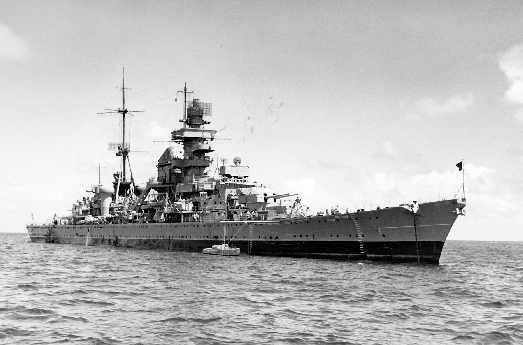
The attack on the Prinz Eugen
17th May, 1942
The Prinz Eugen

The Prinz Eugen was a German navy heavy cruiser, which in early May 1942 was being repaired in Lofjord in Norway after being damaged by a torpedo from the British submarine HMS Trident. The repairs were of a makeshift nature intended to see the ship back to her home port of Kiel in Germany where she could be repaired more permanently. The RAF kept a constant watch on her as she presented a major threat to the Arctic convoys. Two Beaufort squadrons were kept at permanent readiness to strike at the ship. Our chaps in 86 Squadron was stationed at Sumburgh in the Shetlands and 42 Squadron at Leuchars in Scotland.
On the 16th May the Prinz Eugen was spotted steaming for home with an escort of two destroyers. Just before midnight fourteen Beauforts of 86 Squadron took off to attack her. They failed to locate the convoy although a German lookout on the cruiser saw four of the Beauforts astern at one o'clock. The 86 Squadron Operations Record Book (ORB) makes no mention of this raid; according to that source most of the squadron was out on two separate patrols that night. Atkinson and his crew flew aircraft "U", a Beaufort II (tail number AW248), on this mission.
The following day both squadrons were ordered to attack the Prinz Eugen. The plan was that 86 would sweep down parallel to the Norwegian coast attacking from the North-West and that 42 would come in from the opposite direction. The idea was for the two attacks to take place simultaneously or very close together. Fifteen planes of 86 took off from Sumburgh just before six o'clock in the evening. They were escorted by four Beaufighters and a high altitude diversionary force of twelve Hampdens. The other squadron could only raise twelve Beauforts and six Hampdens with another four Beaufighters for escort. 86 was led by Squadron Leader Jimmy Hyde and 42 by Wing Commander Williams. Our crew were on their sixth mission together; it was to be Day's forty-fifth operation.
About an hour after 86 took off aircraft "A", piloted by Flight Lieutenant J C "Boomerang" Brice suffered a starboard engine failure and returned to base. The rest of the formation made landfall at Egero Island (Eigerøy Fyr)and were about to turn south when they received a radio message telling them to turn north instead. They did so, keeping close to the shore.
Very soon after turning north the formation was attacked by eighteen to twenty Messerschmitt 109 fighters from Stavanger airfield. One by one the Beauforts jettisoned their torpedoes in order to gain performance as a twenty minute dogfight developed. The formation was starting to break up and the target hadn't yet been seen when they reached Feiesten Lighthouse (Feistein Fyr). Feistein is very close to the airfield at Sola where most of the German fighters would have been based so it was a rather unfortunate order to send them northwards from Eigerøy earlier. Squadron Leader Hyde led them south again. During the dogfight five enemy aircraft were seen to be on fire when they crashed into the sea. According to the ORB all five enemy aircraft were claimed by the squadron's Beauforts with aircraft "D", piloted by Flying Officer S W Kellow, claiming two of them. Four Beauforts were lost; three of the crews were on their first mission. According to the Luftwaffe's loss records there were four Messerschmitt 109s lost that day, two due to combat. The Luftwaffe pilots all survived.
The incorrect radio message didn't affect 42 squadron as they were already flying in the right direction. They spotted the cruiser at quarter past eight but were attacked by Messerchmitt 109s and 110s from a Luftwaffe Operational Training Unit at Lister. The squadron pressed home its attack on the Prinz Eugen without scoring any hits. Wing Commander Williams was shot down and taken prisoner, the rest of his crew died. 42 squadron also lost four of its crews.
The Prinz Eugen was undamaged and survived the war to briefly become the USS Prinz Eugen. She capsized and sank in 1946 after being used in the Bikini Atoll atomic bomb tests.
Although this raid was a total failure it can in hindsight be viewed as a turning point in both Coastal Command's strategy and its tactics. The strategy switched to attacking convoys of merchant shipping rather than capital ships. The tactics changed to using squadrons of Mosquitoes, Beaufighters and Torbeaus. These aircraft were far more heavily armed than the Beaufort and were able to lay down a withering hail of suppressing fire as they approached the ships. They also later carried rockets mounted under the wings that proved far better than aerial torpedoes for attacking both ships and surfaced submarines. Frank Day's first squadron, 248, was later converted onto Mosquitoes as part of the Banff Strike Wing in the last winter of the war. The Beauforts were pensioned off in the summer of 1942 and ferried out to the Mediterranean.
Much of the detail of this episode was found in "Ship Busters!" by Ralph Barker with additional information provided by the Operational Record Book of 86 Squadron and, of course, Wikipedia.
There is a BBC project, WWII People's War, that has an account of this action related by Allan Hurrell. Allan was also a Rhodesian pilot flying with 86 squadron. He mentions Johnnie Atkinson as his friend in the piece. Allan Hurrell's account
See also this account of the attack on the Prinz Eugen from the point of view of a member of 42 squadron.
There is an interesting account here of the earlier failed attack on Prinz Eugen when she took part in the "Channel Dash" incident earlier in the war.